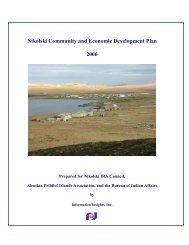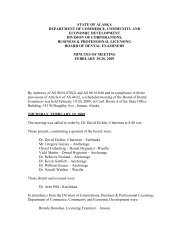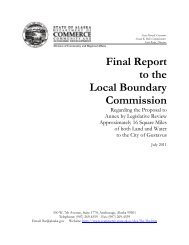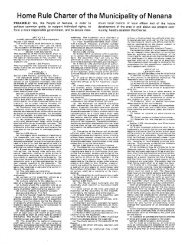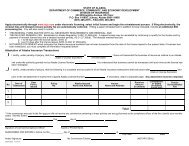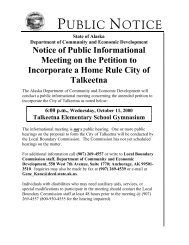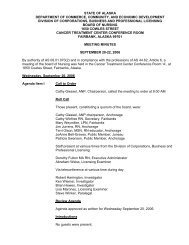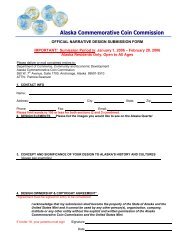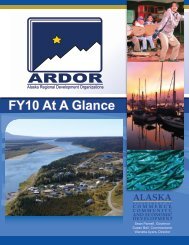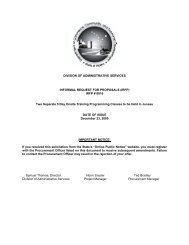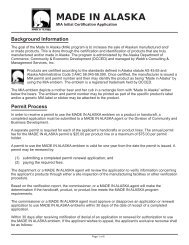Insurance Handbook - Alaska Department of Community and ...
Insurance Handbook - Alaska Department of Community and ...
Insurance Handbook - Alaska Department of Community and ...
Create successful ePaper yourself
Turn your PDF publications into a flip-book with our unique Google optimized e-Paper software.
Updates at www.iii.org/issues_updates <strong>Insurance</strong> Topics<br />
No-Fault Auto <strong>Insurance</strong> <strong>and</strong> Other Auto Liability Auto <strong>Insurance</strong> Systems<br />
No-Fault Auto <strong>Insurance</strong> <strong>and</strong> Other Auto<br />
Liability Systems<br />
State auto liability insurance laws fall into four broad categories: no-fault, choice<br />
no-fault, tort liability <strong>and</strong> add-on. The major differences are whether there are<br />
restrictions on the right to sue <strong>and</strong> whether the policyholder’s own insurer pays<br />
first-party benefits, up to the state maximum amount, regardless <strong>of</strong> who is at<br />
fault in the accident. These alternative systems have evolved over time as consumers,<br />
regulators <strong>and</strong> insurers have sought ways to lower the cost <strong>and</strong> speed up<br />
the delivery <strong>of</strong> compensation for auto accidents.<br />
The term “no-fault” auto insurance is <strong>of</strong>ten used loosely to denote any auto<br />
insurance program that allows policyholders to recover financial losses from<br />
their own insurance company, regardless <strong>of</strong> fault. But in its strictest form n<strong>of</strong>ault<br />
applies only to state laws that both provide for the payment <strong>of</strong> no-fault<br />
first-party benefits <strong>and</strong> restrict the right to sue, the so-called “limited tort”<br />
option. The first-party (policyholder) benefit coverage is known as personal<br />
injury protection (PIP).<br />
Under current no-fault laws, motorists may sue for severe injuries <strong>and</strong> for<br />
pain <strong>and</strong> suffering only if the case meets certain conditions. These conditions,<br />
known as a threshold, relate to the severity <strong>of</strong> injury. They may be expressed in<br />
verbal terms (a descriptive or verbal threshold) or in dollar amounts <strong>of</strong> medical<br />
bills, a monetary threshold. Some laws also include minimum requirements for<br />
the days <strong>of</strong> disability incurred as a result <strong>of</strong> the accident. Because high threshold<br />
no-fault systems restrict litigation, they tend to reduce costs <strong>and</strong> delays in paying<br />
claims. Verbal thresholds eliminate the incentive to inflate claims that may<br />
exist when there is a dollar “target” for medical expenses. However, in some<br />
states the verbal threshold has been eroded over time by broad judicial interpretation<br />
<strong>of</strong> the verbal threshold language, <strong>and</strong> PIP coverage has become the target<br />
<strong>of</strong> abuse <strong>and</strong> fraud by dishonest doctors <strong>and</strong> clinics that bill for unnecessary <strong>and</strong><br />
expensive medical procedures, pushing up costs.<br />
Currently 12 states <strong>and</strong> Puerto Rico have no-fault auto insurance laws.<br />
Florida, Michigan, New Jersey, New York <strong>and</strong> Pennsylvania have verbal<br />
thresholds. The other seven states—Hawaii, Kansas, Kentucky, Massachusetts,<br />
Minnesota, North Dakota <strong>and</strong> Utah—use a monetary threshold. Three states<br />
have a “choice” no-fault law. In New Jersey, Pennsylvania <strong>and</strong> Kentucky, motorists<br />
may reject the lawsuit threshold <strong>and</strong> retain the right to sue for any autorelated<br />
injury.<br />
I.I.I. <strong>Insurance</strong> <strong>H<strong>and</strong>book</strong> www.iii.org/insuranceh<strong>and</strong>book 55



